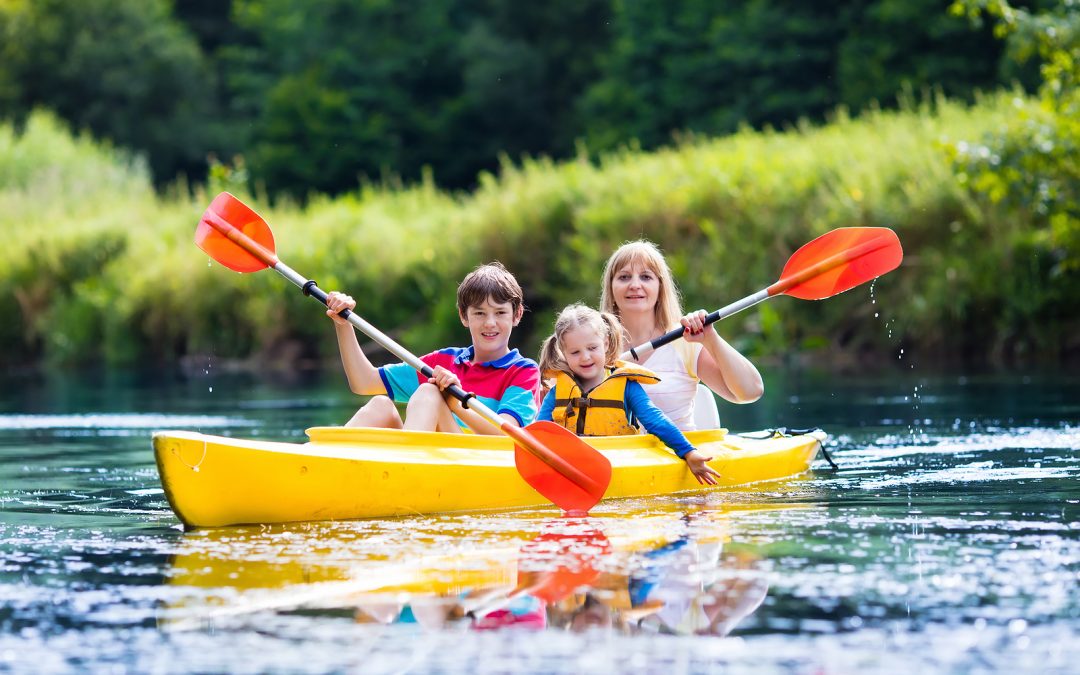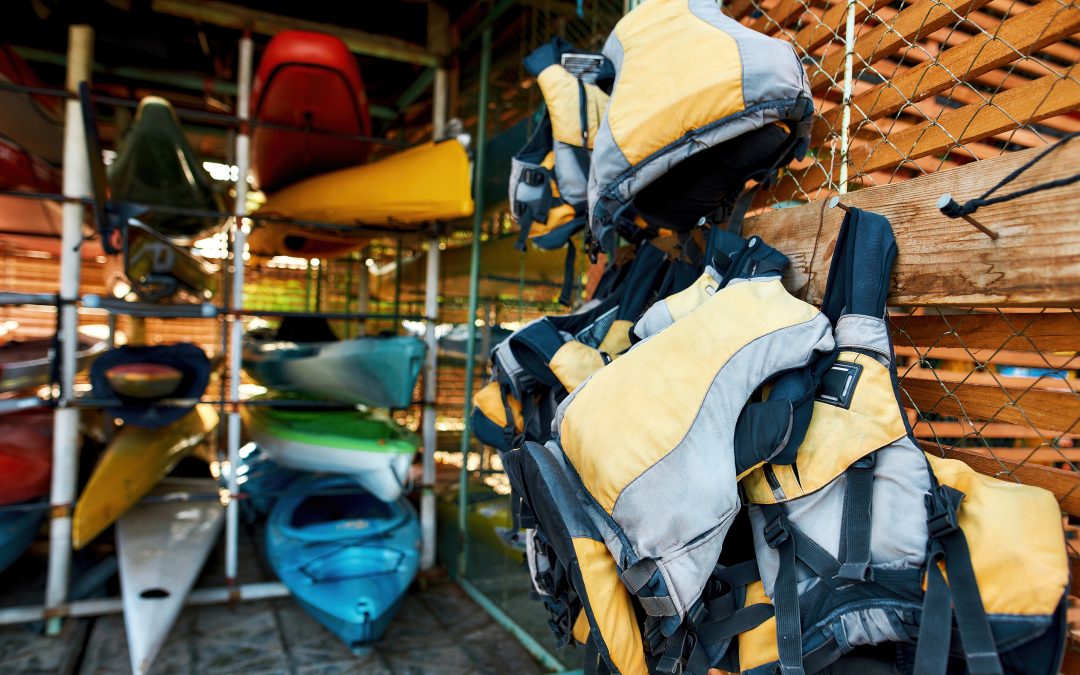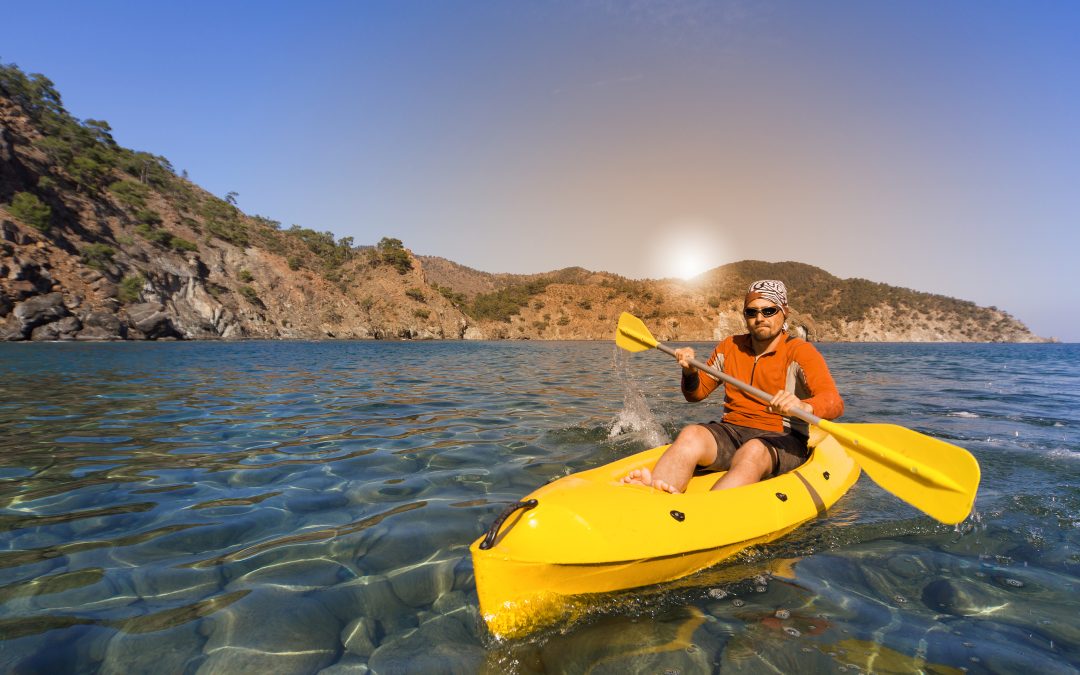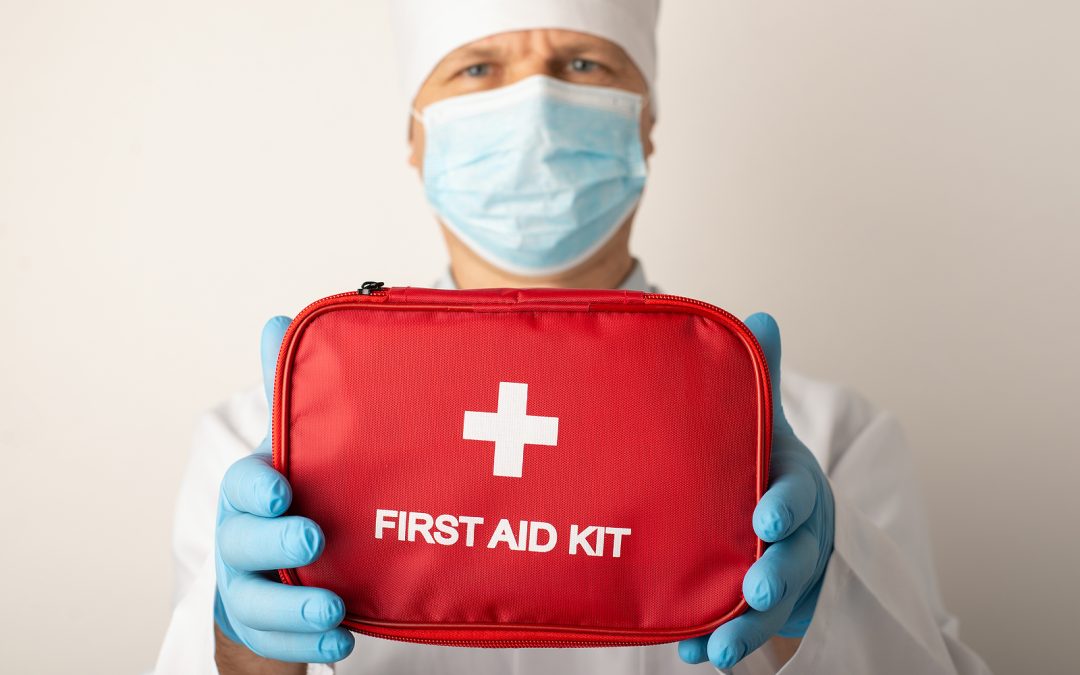Kayaking is a popular outdoor activity that offers a great opportunity to explore the beauty of nature and enjoy some physical exercise. However, like any other outdoor activity, kayaking comes with its own set of risks. To ensure a safe and enjoyable kayaking experience, it is important to follow some basic safety tips.

Understanding the basics of kayaking is the first step towards ensuring safety. Kayaking involves paddling in a small watercraft, typically propelled by a double-bladed paddle. Essential safety gear such as a personal flotation device (PFD), helmet, and proper clothing are necessary to protect oneself from accidents and hypothermia. Pre-trip planning, including checking weather conditions, water levels, and tides, is equally important to ensure a safe kayaking experience.
Key Takeaways
- Understanding the basics of kayaking is essential for a safe kayaking experience.
- Essential safety gear such as a personal flotation device (PFD), helmet, and proper clothing are necessary to protect oneself from accidents and hypothermia.
- Pre-trip planning, including checking weather conditions, water levels, and tides, is equally important to ensure a safe kayaking experience.
Understanding Kayaking Basics
Kayaking is a fun and exciting way to explore the water. However, it is important to understand the basics of kayaking to ensure a safe and enjoyable experience. This section will cover the types of kayaks and kayaking techniques.
Types of Kayaks
There are several types of kayaks available, each designed for different purposes. Sit-on-top kayaks are popular for recreational use and are easy to get in and out of. Sea kayaks are designed for longer trips and are more stable in rough water. Sit-inside kayaks provide better protection from the elements and are ideal for colder climates.
Kayaks can also vary in size and shape. Longer kayaks are faster and more efficient, while shorter kayaks are more maneuverable. The shape of the kayak’s hull also affects its performance. Flat hulls are more stable, while rounded hulls are faster.
Kayaking Techniques
Proper kayaking techniques are essential for safety and efficiency on the water. The first step is to ensure proper paddling technique. The paddle should be held with both hands, with the hands shoulder-width apart. The paddle blade should be angled to catch the water and pull it towards the paddler.
It is also important to understand how to maneuver the kayak. Turning the paddle in the water will cause the kayak to turn in the opposite direction. Leaning to one side of the kayak can also cause it to turn.
In addition to paddling and maneuvering, it is important to understand how to properly enter and exit the kayak. When entering the kayak, the paddler should sit down in the center of the seat and swing their legs into the kayak. When exiting, the paddler should reverse the process and swing their legs out of the kayak before standing up.
By understanding the different types of kayaks and proper kayaking techniques, paddlers can have a safe and enjoyable experience on the water.
Essential Safety Gear
When it comes to kayaking, safety should be a top priority. Having the right gear can make all the difference in case of an emergency. Here are some essential safety gear that every kayaker should have:
Personal Flotation Devices
A personal flotation device (PFD) is a must-have for kayakers, regardless of their skill level. According to REI Expert Advice, a PFD should be worn at all times while on the water. A kayaking specific life jacket is recommended as it is designed to provide maximum comfort and mobility while on the water. It is important to ensure that the PFD fits properly and is in good condition.
Protective Clothing
Kayaking involves being in contact with water, so it is essential to wear appropriate clothing. A wetsuit or drysuit is recommended depending on the water temperature. A wetsuit is suitable for warmer water, while a drysuit is recommended for colder water. In addition, a helmet is recommended for whitewater kayaking, while a spray skirt is recommended for all types of kayaking to keep water out of the kayak.
Safety Accessories
Apart from PFDs and protective clothing, there are other safety accessories that kayakers should have. A whistle is recommended for signaling for help, while a headlamp is recommended for kayaking at night. It is also recommended to carry a first aid kit, a knife, and a spare paddle in case of an emergency.
In summary, having the right safety gear is crucial for a safe and enjoyable kayaking experience. Kayakers should ensure that they have a suitable PFD, protective clothing, and safety accessories before hitting the water.
Pre-Trip Planning
Before embarking on a kayaking trip, it is essential to plan ahead to ensure a safe and enjoyable experience. Pre-trip planning involves considering various factors such as weather and water conditions, float plan and communication, and local knowledge.
Weather and Water Conditions
Checking the weather forecast and water temperature is crucial before heading out on a kayaking trip. Wind speed, wave height, and precipitation can affect the safety and comfort of the kayaker. Kayaking in extreme weather conditions is not recommended, and kayakers should always err on the side of caution.
Float Plan and Communication
Creating a float plan is an important part of pre-trip planning. A float plan outlines the intended route, expected time of arrival, and emergency contact information. In case of an emergency, having a float plan can help rescuers locate the kayaker quickly. Additionally, kayakers should carry a communication device such as a VHF radio or a cell phone to call for help if needed.
Local Knowledge
Having knowledge of local hazards and boating rules is necessary for a safe kayaking trip. Kayakers should research the area they plan to paddle, including potential hazards such as rocks, rapids, and strong currents. It is also essential to know local boating rules, such as speed limits, no-wake zones, and right-of-way rules. Choosing a suitable kayaking location is also crucial. Kayakers should consider their skill level and experience when selecting a location.
Overall, pre-trip planning is an essential part of kayaking safety. By considering weather and water conditions, creating a float plan, and having local knowledge, kayakers can ensure a safe and enjoyable experience on the water.
Kayaking Safety Procedures
Kayaking is an enjoyable and exciting way to explore the great outdoors, but it is important to follow safety procedures to ensure a safe and fun experience. In this section, we will cover general safety rules, rescue techniques and self-rescue, and handling capsizing and emergencies.
General Safety Rules
Before embarking on a kayaking trip, it is important to follow these general safety rules:
- Wear a personal flotation device (PFD) at all times.
- Dress appropriately for the weather and water temperature.
- Always carry a first-aid kit and know how to use it.
- Check weather and water conditions before setting out.
- Stay alert and aware of your surroundings.
- Avoid alcohol and drugs while kayaking.
Rescue Techniques and Self-Rescue
In the event of an emergency, it is important to know how to rescue yourself and others. Some essential rescue techniques and self-rescue methods include:
- Using a bilge pump to remove water from the kayak.
- Using a paddle float to re-enter the kayak after capsizing.
- Using a towline to tow another kayak to safety.
- Knowing how to perform a T-rescue to rescue another kayaker.
Handling Capsizing and Emergencies
Capsizing and other emergencies can happen, so it is important to know how to handle these situations. Here are some tips:
- Stay calm and assess the situation.
- If you capsize, try to stay with your kayak and paddle.
- If you can’t re-enter the kayak, swim to shore or a safe location.
- If someone is injured, use your first-aid kit to provide medical assistance.
- If you are lost or stranded, signal for help using a whistle or communication device.
By following these safety procedures, kayakers can enjoy a safe and fun experience on the water. Remember to always be prepared and aware of your surroundings.
Risk Management
Kayaking is a water sport that can be both fun and exhilarating. However, like any outdoor activity, it comes with inherent risks that should be managed to ensure a safe and enjoyable experience. Risk management is an essential aspect of kayaking, and it involves identifying potential hazards, assessing the risks, and taking measures to mitigate them.
Avoiding Hazards
Kayakers should always be aware of the potential hazards in the water. Hazards can include underwater obstructions, such as rocks and logs, motorized boat traffic, and dams. Whitewater kayaking, in particular, poses additional risks, such as strong currents and rapids. To avoid hazards, kayakers should always plan their route and familiarize themselves with the water conditions beforehand. They should also wear appropriate safety gear, such as a personal flotation device (PFD) and a helmet.
Dealing with Weather and Water Risks
Extreme weather conditions, such as strong winds and heavy rain, can make kayaking more challenging and increase the risk of capsizing. Kayakers should always check the weather forecast before heading out and avoid kayaking in severe weather. Additionally, kayakers should be aware of the water conditions, such as water temperature and currents, and adjust their route and paddling accordingly.
Preventing Hypothermia and Cold Water Shock
Hypothermia and cold water shock are two of the most significant risks associated with kayaking in cold water. Hypothermia occurs when the body loses heat faster than it can produce it, while cold water shock is a sudden and involuntary gasp reflex that can occur when the body is exposed to cold water. To prevent hypothermia and cold water shock, kayakers should dress appropriately for the water temperature, wear a wetsuit or drysuit if necessary, and avoid sudden immersion in cold water. Additionally, kayakers should always carry a change of clothes in a waterproof bag in case of an emergency.
In summary, risk management is an essential aspect of kayaking that involves identifying potential hazards, assessing the risks, and taking measures to mitigate them. Kayakers should always be aware of the potential hazards in the water, check the weather forecast, and adjust their route and paddling accordingly. They should also dress appropriately for the water temperature and carry a change of clothes in case of an emergency. By following these safety tips, kayakers can enjoy a safe and enjoyable experience on the water.
Legal and Ethical Considerations

Kayaking is a fun and exciting outdoor activity that can be enjoyed by people of all ages and skill levels. However, it is important to remember that kayaking comes with certain legal and ethical responsibilities. In this section, we will discuss some of the key considerations that kayakers should keep in mind.
Boating Rules and Regulations
Kayakers are subject to the same boating rules and regulations as other watercraft. These rules are in place to ensure the safety of all water users and to protect the environment. Some of the key rules and regulations that kayakers should be aware of include:
-
Wearing a PFD: The U.S. Coast Guard requires all kayakers to wear a Personal Flotation Device (PFD) while on the water. This is not only a legal requirement but also a common-sense safety precaution. Kayakers should choose a PFD that fits them properly and is appropriate for the type of water they will be paddling in.
-
Navigation Lights: Kayakers are required to use navigation lights when operating in low-light conditions or during periods of limited visibility. These lights help other water users to see the kayaker and avoid collisions.
-
Speed Limits: Kayakers should be aware of any speed limits in the area where they are paddling. Excessive speed can be dangerous and can cause damage to the environment.
-
Wildlife Protection: Kayakers should always be respectful of the environment and the wildlife that inhabits it. This means avoiding disturbing nesting sites and other sensitive areas, and keeping a safe distance from wildlife.
Environmental Responsibility
Kayakers have a responsibility to protect the environment and minimize their impact on natural resources. Some of the key environmental considerations that kayakers should keep in mind include:
-
Leave No Trace: Kayakers should always follow the principles of Leave No Trace. This means packing out all trash and other waste, avoiding damaging vegetation, and minimizing campfire impacts.
-
Respect Wildlife: Kayakers should always respect the wildlife that they encounter on the water. This means avoiding feeding or harassing animals, and keeping a safe distance from nesting sites and other sensitive areas.
-
Support Conservation Efforts: Kayakers can support conservation efforts by volunteering with local organizations, participating in clean-up events, and advocating for policies that protect natural resources.
By following these legal and ethical considerations, kayakers can enjoy their time on the water while also protecting the environment and promoting safety for all water users.
Additional Safety Tips

Kayaking can be a fun and exhilarating experience, but it is important to remember that it can also be dangerous. In addition to the basic kayaking safety tips, there are some additional precautions that kayakers should take to ensure their safety on the water.
Solo Kayaking Precautions
Kayaking alone can be a peaceful and meditative experience, but it is important to take extra precautions when kayaking solo. Before setting out on a solo kayaking trip, it is important to let someone know your planned route and expected return time. This way, if you do not return on time, someone will know to look for you.
It is also important to bring along a buddy if possible, even if they are not kayaking with you. Having someone on shore who knows your planned route and expected return time can provide an extra layer of safety.
Group Kayaking Dynamics
When kayaking with a group, it is important to establish clear communication and safety protocols. Before setting out on a kayaking trip, make sure everyone in the group is familiar with the planned route and any potential hazards.
It is also important to designate a leader for the group who is responsible for making decisions and ensuring the safety of the entire group. In addition, it is a good idea to establish a buddy system within the group, so that each kayaker has someone to look out for them and vice versa.
By following these additional safety tips, kayakers can enjoy their time on the water while also ensuring their safety. Remember to always prioritize safety over fun and to be prepared for any potential hazards that may arise.
Emergency Preparedness
Kayaking can be a fun and exciting activity, but it’s important to be prepared for emergencies. In this section, we will cover some essential emergency preparedness tips.
Emergency Signaling
In case of an emergency, it’s important to have a way to signal for help. A few items that can be used for signaling include a whistle, a VHF radio, and visual distress signals. A whistle is an inexpensive and effective way to signal for help, while a VHF radio can be used to communicate with others in case of an emergency. Visual distress signals, such as flares or smoke signals, can also be used to attract attention.
First Aid and Injury Management
Kayaking can be a physically demanding activity, and injuries can occur. It’s important to have a well-stocked first aid kit on hand in case of an emergency. The kit should include items such as bandages, gauze, antiseptic, and pain relievers. It’s also important to know how to manage injuries, such as cuts, scrapes, and bruises. In case of a more serious injury, such as a broken bone or a head injury, it’s important to seek medical attention as soon as possible.
Overall, being prepared for emergencies is key to staying safe while kayaking. By having the right equipment and knowledge, kayakers can enjoy their activity with confidence.
Best Practices for Kayakers

Kayaking is a fun and exciting way to explore the great outdoors. However, it’s important to take safety seriously to ensure a safe and enjoyable experience. Here are some best practices for kayakers to keep in mind:
Alcohol and Substance Use
One of the most important safety rules for kayaking is to avoid alcohol and other substances. Alcohol can impair judgment, balance, and coordination, increasing the risk of accidents and injuries. It’s best to save the drinks for after the kayaking trip.
Sun Protection and Hydration
Kayakers should also protect themselves from the sun and stay hydrated. Sun exposure can cause sunburn, dehydration, and heat exhaustion. It’s important to wear sunscreen and protective clothing, such as a hat and sunglasses.
Kayakers should also bring enough water to stay hydrated throughout the trip. Dehydration can cause fatigue, headaches, and dizziness, which can be dangerous while kayaking. It’s recommended to drink water every 15-20 minutes to stay hydrated.
Remember, safety should always be a top priority while kayaking. By following these best practices, kayakers can have a safe and enjoyable experience on the water.
Frequently Asked Questions

What essential safety equipment should I carry when kayaking?
Kayaking is a fun and exciting activity, but safety should always be a top priority. To ensure a safe kayaking experience, it is essential to carry certain safety equipment. According to kayakbase.com, some of the essential safety equipment include a personal flotation device (PFD), a whistle, a communication device, sunscreen, a dry bag, a first aid kit, and a knife. These items can help keep you safe in case of an emergency.
How should I dress for kayaking in cold water environments?
When kayaking in cold water environments, it is crucial to dress appropriately to avoid hypothermia. According to REI, kayakers should wear a wetsuit or drysuit, neoprene gloves, and booties to keep warm. It is also essential to wear a hat and a waterproof jacket to keep your head and upper body dry.
What are the critical safety tips beginners should know before kayaking?
Beginners should know some critical safety tips before kayaking. According to kayakingnear.me, some of the essential safety tips include avoiding alcohol, wearing a PFD, checking weather and water conditions, informing someone about your plans, carrying necessary safety gear, and learning rescue techniques. Additionally, beginners should avoid paddling alone and always paddle within their skill level.
Can non-swimmers participate in kayaking, and what precautions are necessary?
Non-swimmers can participate in kayaking, but they must take extra precautions. According to floatingauthority.com, non-swimmers should wear a PFD and avoid kayaking alone. It is also essential to stay close to the shore and avoid deep water.
What should be included in a kayak survival kit?
A kayak survival kit should include essential items to keep you safe in case of an emergency. According to Kayak Scout, some of the essential items include a PFD, a whistle, a communication device, a first aid kit, a knife, a flashlight, a map, and a compass. These items can help you survive in case of an emergency.
What are the key rules and regulations to follow for safe kayaking?
To ensure safe kayaking, it is crucial to follow some key rules and regulations. According to kayakbase.com, some of the key rules and regulations include wearing a PFD, avoiding alcohol, respecting other water users, knowing the local water regulations, and avoiding sensitive wildlife areas. By following these rules and regulations, kayakers can ensure a safe and enjoyable experience on the water.
Conclusion

Kayaking can be a fun and exciting way to explore the outdoors, but it is important to prioritize safety to avoid accidents. By following the tips outlined in this article, kayakers can minimize the risks associated with the activity and enjoy their time on the water.
Some of the key takeaways for kayaking safety include wearing a personal flotation device (PFD) at all times, checking the weather and water conditions before heading out, and avoiding alcohol and drugs while on the water. It is also important to paddle with a partner or group and to let someone know your planned route and expected time of return.
In addition to these general safety tips, kayakers should also be mindful of the specific hazards associated with their chosen location and adjust their equipment and technique accordingly. For example, kayaking on a river with rapids requires different skills and equipment than kayaking on a calm lake.
By staying aware of potential hazards and taking the necessary precautions, kayakers can enjoy their time on the water with confidence and peace of mind.











